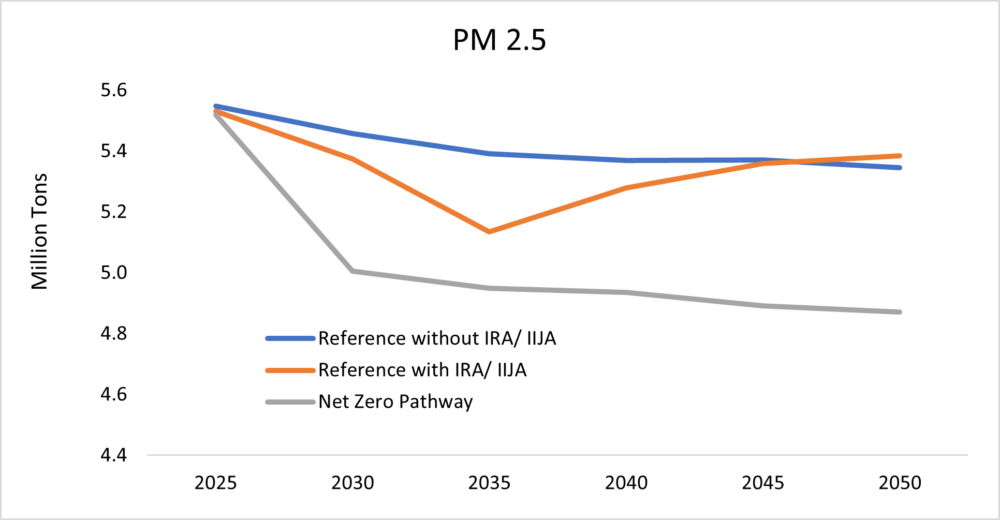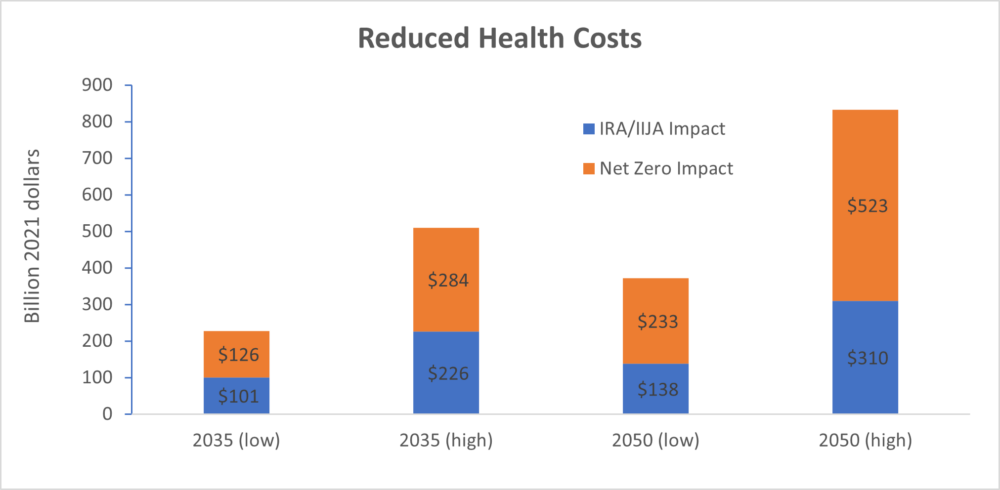
Communities and ecosystems continue to suffer the consequences of human-caused climate change, primarily from the burning of fossil fuels across our economy. The full lifecycle of fossil fuels, which includes exploration, extraction, processing, storage, transportation, combustion, and waste disposal, threatens the health of our planet and communities—with the burden disproportionately being borne by communities of color and low-income communities.
The case for phasing out of fossil fuels and making a just and equitable transition to clean energy has never been more clear.
Recently, The Union of Concerned Scientists (UCS) published a modeling analysis, Accelerating Clean Energy Ambition: How the United States Can Meet Its Climate Goals While Delivering Public Health and Economic Benefits that looked at different pathways for decarbonizing the US economy while optimizing for energy-system cost.
New in this UCS analysis is a look at the public health co-benefits of reducing air pollution from fossil fuels that occur from decarbonizing our economy. Knowing what these substantial benefits are can help us better understand the true impacts of reducing our fossil fuel emissions.
What is fine particulate matter and what does it do to our health?
Fine particulate matter–or PM2.5 for our purposes–refers to tiny particles in the air that can be found in sources like smoke, dust, soot, or even liquid. The “2.5” refers to the maximum size of the particle, 2.5 micrometers. To contextualize that, the Environmental Protection Agency describes PM2.5 like this: “Think about a single hair from your head. The average human hair is about 70 micrometers in diameter—making it 30 times larger than the largest fine particle.”
The miniscule size of these particles is part of the reason why they can be so harmful to our health. Once inhaled, they can become lodged in the lungs or even the bloodstream, leading to issues like respiratory conditions, lung cancer, asthma, low birth weight, heart attacks, damage to the nervous system, and death, including infant mortality. PM2.5 can also reduce visibility, making certain activities such as driving more risky.
Sources of PM2.5 can naturally occur in our environment, for example, a volcanic eruption that releases soot into the air, but a major source of PM2.5 comes from burning fossil fuels. Proximity to coal and methane gas plants, and pollution from gas and diesel vehicles can increase one’s exposure to PM2.5.
A study from Harvard found that in 2018, eight million people died from fossil fuel pollution—that’s 1 in every 5 deaths.
UCS modeled the impacts of reduced emissions on public health
As part of our research in the new Accelerating Clean Energy Ambition report, UCS undertook analyses to study the impacts of reducing carbon emissions on public health. We quantified these impacts using EPA’s CO-Benefits Risk Assessment (COBRA) model, which uses inputs on ambient concentration of PM2.5 to estimate public health impacts, such as the number of mortalities, asthma attacks, and hospital admissions. The model also monetizes those results to help us understand the costs or savings of certain outcomes.
Although there are multiple pollutants that can contribute to adverse health conditions, this particular model focuses exclusively on PM2.5 levels. Exposure to PM2.5 is responsible for most pollution-related deaths, so the focus on this pollutant makes sense.
It’s important to note that we did not examine the impacts of pollution reduction using a specific equity lens. That is to say, our results give us a general idea of how many lives might be affected or how much money could be saved, but they do not provide us with specific information on who might reap the benefits of transitioning away from fossil fuels to clean energy. Contrast that with some of the wider benefits of the clean energy transition, such as phasing out coal generation by 2030, which are realized by everyone including historically disenfranchised groups. Programs enacted by the Inflation Reduction Act, passed by Congress last year, provide incentives for low-income households that will likely translate to added health benefits.
Still, there is plenty of other research that helps put equity issues into context.
A 2021 study found that a majority of PM2.5 exposure sources systemically affected racial and ethnic minorities disproportionately. These sources of PM2.5 varied but were found to unfairly impact racial and ethnic minorities across source types and locations. The authors also discuss how racist legacy housing practices have led to increased exposure to PM2.5 for communities of color. And, they point to the systemic change which is needed to address these inequities.
A separate UCS analysis back in 2019 also captured the inequitable burdens of pollution from road vehicles. It found that people who identify as Asian, African American, and Latinx are exposed to disproportionately higher rates of PM2.5.
Reducing fossil fuel pollution leads to fewer deaths and more healthcare savings
UCS found that decarbonization policies result in a decline in key pollutants such as PM2.5, nitrogen oxides, and sulfur oxides.
When we compare two scenarios, the first without major decarbonization policies like the Inflation Reduction Act, and the second with a pathway to net zero by 2050, we find a substantial difference in the tons of ambient pollutants that are harmful to our health. The benefits of reducing fossil fuel-produced pollution of PM2.5 are enormous for public health.

Implementing clean energy policies that decrease the amount of PM2.5 in the air can save us between $225 to $506 billion in total healthcare costs in 2035, and between $368 to $826 billion in 2050. Health results include low and high estimates (shown below) due to a range of data available from sources used in the COBRA model.

The stacked benefits of the IRA/IIJA and a net zero pathway offer huge, combined savings. This includes costs like hospitalizations due to asthma, illnesses, heart attacks, and mortalities attributed to PM2.5 exposure, as well as work days lost and activity restricted due to illness.
But decarbonizing our economy doesn’t just save us money. By reducing harmful levels of pollution, we can save tens of thousands of lives as shown in the chart below.

One last point about these health results is that they did not include mortalities or health impacts caused by climate change.
According to the National Ocean and Atmospheric Administration (NOAA), in 2023 alone there have been 25 confirmed climate disaster events affecting the United States with costs exceeding $1 billion each. Furthermore, additional research suggests that a warming climate could be responsible for an increase in heat-related deaths. In our analysis, UCS used the social cost of carbon to estimate the avoided costs of damages due to reducing carbon emissions. By 2050, this yields around $250 billion under the IRA/IIJA scenario and around $1.2 trillion under the net zero pathway.
Combined with our total health benefits, we see huge savings when we reduce emissions.
It’s clear why we must decarbonize our economy
Exposure to harmful pollutants caused by the burning of fossil fuels has tragically resulted in a great number of premature deaths, many of which have been experienced by historically disenfranchised communities. Adopting policies that transition our economy away from fossil fuels could spare us more unnecessary illness and loss of life.
A modeling analysis of a decarbonized economy, like that completed this year by UCS, helps us understand the potential public health savings we can achieve through policy and technology deployments.
Although existing policies like the IRA and other state-level policies offer significant benefits, additional policies and investments are needed at the state and federal levels for the US to reach its short- and long-term climate goals.
Following through on a net zero pathway will help us save money and lives. We need to prioritize under-resourced communities who face disproportionate harm from fossil fuels, and commit to making the transition to clean energy an equitable one for all people.






